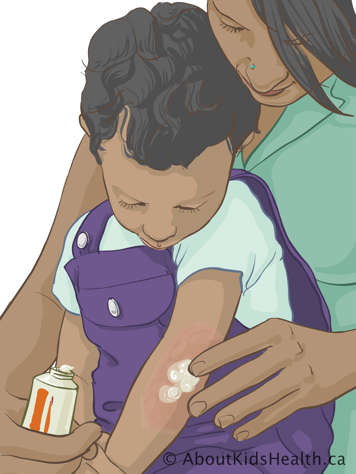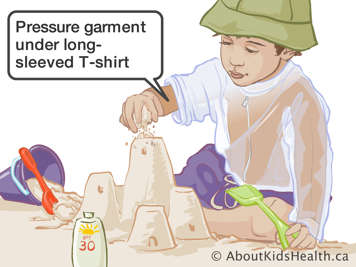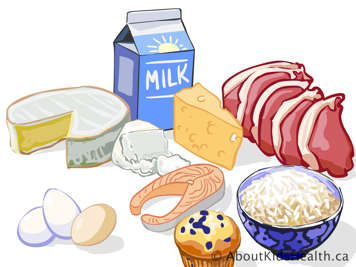Coming home from the hospital is a happy time. It means your child is getting better. At home, you will have to take care of your child and help your child's burn injury heal.
Most families find that it takes some time to get into a routine. Here are some tips:
- Ask for help from other family members.
- Include your child's treatment into your regular family life. Do not centre family life on the treatment.
- At first, some children need more naps, demand more attention or have nightmares. If this happens, be calm and understanding. These problems will go away with time.
- Try to set aside a few private minutes for yourself each day.
Caring for your child's healing skin
Here are some tips to help you care for your child's healing skin.
Washing
It is very important to keep the new skin clean. Clean your bathtub as you normally would. Be sure to wash your own hands before caring for your child's skin.
Bathe your child, including the healed skin, in a warm soapy bath or shower once a day. You can use regular soap. Pat the skin dry; do not rub it.
If your child still has open wounds, they should not bathe with other people.
Skin creams
The longer the burn injury took to heal, the more chance there will be scars. You cannot stop scars from forming, but you can help minimize the appearance of burn scars with proper skin care and regular massage with a good skin cream. Be sure to use a cream without perfumes.
Apply the cream and massage firmly and evenly over the areas using your fingertips. Continue until all the cream is absorbed into the skin. This should take about five minutes. Many children find this treatment soothing. It usually relieves the itchiness.
Some children find their new skin to be very sensitive to touch. It is very important that you keep touching it. The more the area is touched, the less sensitive it will be.

Itchiness
Healed skin can be itchy. Extra baths and skin cream may help make skin less itchy. Some children may also need to take medicine for a short time to reduce itchiness. Your doctor or nurse will advise you on how to manage the itch.
Keep your child's nails short and clean to help prevent scratching or infection.
Open skin
If there are small open wounds, cover them with some petroleum jelly and a light gauze dressing after cleaning with soap and water in the bath. If the dressing sticks, you can remove it gently by soaking in the next bath. After the bath, you will need to put on a new dressing with ointment and gauze. If you have any questions, call the burn unit where your child was treated.
Heat, cold and sunlight
Protect your child's newly healed skin from heat and cold as it can be hyper-sensitive. The skin will also burn easily. Keep your child out of direct sunlight and apply a waterproof sun block with a sun protection factor (SPF) of at least 30.
Your child should also wear light-coloured clothing over the burned area. If new skin is exposed to sunlight, it will darken evenly and this colour will be permanent.
In very cold weather, dress your child warmly.
Blisters and sores
Sometimes, healed skin can blister or small sores may appear. This may happen during the first few months whenever the skin is bumped or scratched. This is normal, so try not to discourage usual play and activity. Blisters will heal quickly when treated in the same way as open skin areas. Over time, the new skin heals and becomes stronger.
Pressure garments?
If your child needs pressure garments:
- Garments must be worn 24 hours a day and taken off only for bathing.
- Garments do not filter out sunlight. Your child must still use a sun block under the garments.
- Change the garments after each bath. Wash them in warm soapy water and dry them flat. Do not put pressure garments in the dryer or near a radiator, as this may damage the material.

Activity
Parents often worry about their child's safety after the burn. However, your child can do all the activities that they are used to doing, unless your child's doctor, nurse or physiotherapist has told you something else. If you have questions call the burn unit where your child was treated.
Eating and drinking
Good nutrition will help your child's burn heal. However, the return home may cause some children to become fussy about eating. They may have less appetite or even lose a little weight in the first few weeks. This problem does not last and will go away by itself. Serve your child foods that are high in protein and energy. Good examples are meats, eggs, yogourts, cheese and pasta.

Outings
Getting out and meeting other people is important for your child's emotional health. If your child has visible scarring, some people may react when they first see the scar. This response is normal and will become easier for you, your child and your family to understand and accept. Some people may ask awkward questions. You may find it helpful to prepare a truthful answer ahead of time.
Return to school
Depending on the extent and visibility of the burn injury, your child may find returning to school difficult. School has a strong influence on a child's normal behaviour and social adjustment. Talk to your burn team to discuss a school re-entry visit to support your child's return to school.
Follow-up clinic
Your child will have to go to a follow-up clinic. The doctors and nurses will check how your child's burn is healing. They will also ask how your family is doing now that you are at home.
Write down the date, time, and place of your follow-up visit here:
Getting help
Questions will arise as you adjust to your new routines. Here are three ways to find answers:
- Call the burn unit where your child was treated or your plastic surgeon. Someone is always available.
- Bring your questions with you to the clinic. Write them down before you go so you do not forget any questions when you arrive.
- Contact your family physician for health concerns that are not related to the burn injury.
Write down helpful names and numbers here: